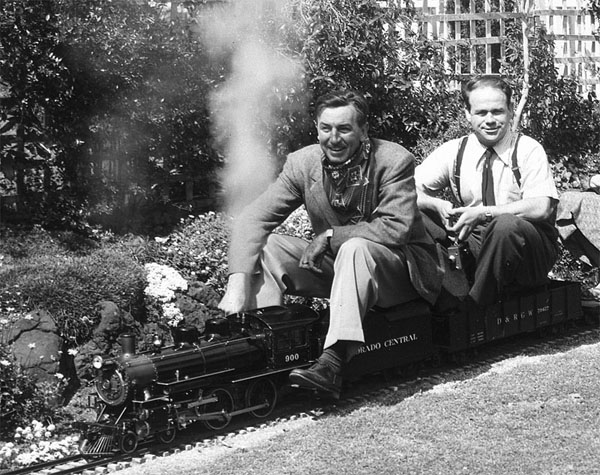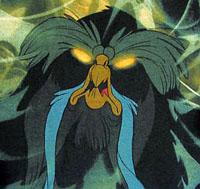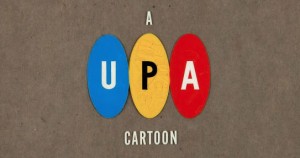Walt and Ward. From Videographi magazine December 1986, Ward Kimball shared the following thoughts with writer John Rice: “In the Golden Age of animation, there was always a desire to do good animation. The problem has always been money. Animation has deteriorated because people aren’t putting money into it. The future for animation is computer generated graphics and effects. It fascinates me. In Pinocchio and Fantasia, we didn’t have the luxury of the computer. It all had to be done by hand so we were limited.

“Walt knew when someone wasn’t doing any work. He would come in to the offices on Saturdays and Sundays. He would look over people’s desks and see how things were coming. He might get an idea and then call the animator or director into his office on Monday morning but never admit that he’d been at their desk over the weekend.
“There are other types of geniuses out there today but never exactly like Walt. I consider Jim Henson a genius. But no one will be exactly like Walt. He came along with the right mind at the right time and he had the talent at just the right point in history. You can’t duplicate it. But why duplicate it? There are new things!”
 Color Controversy. In the Minneapolis Star Tribune of July 16, 1982, animator Gary Goldman who was promoting the release of The Secret of NIMH (1982) stated, “When I first looked at Pinocchio as an adult, I said, ‘I can’t believe they did that. That is gorgeous’. My goodness, forty years have passed and we can’t do it as good as they did it in 1940. It’s because we lost the three-color process, sold it to China. That’s what Gone With the Wind was done with and that’s what Bambi and Pinocchio were done with.
Color Controversy. In the Minneapolis Star Tribune of July 16, 1982, animator Gary Goldman who was promoting the release of The Secret of NIMH (1982) stated, “When I first looked at Pinocchio as an adult, I said, ‘I can’t believe they did that. That is gorgeous’. My goodness, forty years have passed and we can’t do it as good as they did it in 1940. It’s because we lost the three-color process, sold it to China. That’s what Gone With the Wind was done with and that’s what Bambi and Pinocchio were done with.
“Each frame of film is shot three times. One with red, one with yellow and one with blue. Then they’re split and combined. It’s a dye process rather than a photography process. That’s why those old films look so vivid and rich. We’ve lost all that today.” Goldman said 1.5 million drawings were combined to get the 120,000 finished drawings shown on the screen.
 Bluth Animation Philosophy. In the New York Times November 7, 1986, animator and director Don Bluth said, “Animation is really an enigma to most people. The characters you see on screen are actually symbols. A witch is drawn like a person, but she really represents something else. That is why animation is like poetry. It is symbolic communication. Through villains and witches, children come to understand that there is good and evil in the world and they must see that good wins and evil loses.
Bluth Animation Philosophy. In the New York Times November 7, 1986, animator and director Don Bluth said, “Animation is really an enigma to most people. The characters you see on screen are actually symbols. A witch is drawn like a person, but she really represents something else. That is why animation is like poetry. It is symbolic communication. Through villains and witches, children come to understand that there is good and evil in the world and they must see that good wins and evil loses.
“The reason the Disney films are classics is that they are frightening. As long as they are rescued from the scary, the scary has a purpose. You want to show that evil can be overcome. If you take true villainy and water in down, you take away its meaning for the child. Steven (Spielberg) was very insistent that his son, Max who is one year old could watch (An American Tail 1986) without reprecussions.”
 UPA Animation. Paul Etcheverry did an extensive interview with Bill Scott on his lengthy animation career on November 24, 1981. Here is an excerpt about limited animation: “I think Bill Melendez expressed it best. He was one of the finest UPA animators and knew the style as well as anyone and he said, ‘We put in no uneccessary drawings’. There wasn’t animation for animation’s sake. I recently saw Disney’s Alice in Wonderland (1951) again. I watched scene after scene where the animation tired you out. Everything was moving all the time. Great gusts and wafts of brilliant animation so that all the animation began to look the same after a while. We used to call Disney animation “wormy”. Everything seemed to be crawling and moving at once. So UPA had a policy of movement when it’s required but otherwise, not.”
UPA Animation. Paul Etcheverry did an extensive interview with Bill Scott on his lengthy animation career on November 24, 1981. Here is an excerpt about limited animation: “I think Bill Melendez expressed it best. He was one of the finest UPA animators and knew the style as well as anyone and he said, ‘We put in no uneccessary drawings’. There wasn’t animation for animation’s sake. I recently saw Disney’s Alice in Wonderland (1951) again. I watched scene after scene where the animation tired you out. Everything was moving all the time. Great gusts and wafts of brilliant animation so that all the animation began to look the same after a while. We used to call Disney animation “wormy”. Everything seemed to be crawling and moving at once. So UPA had a policy of movement when it’s required but otherwise, not.”
Barbera Talks Jetsons the Movie. In USA Today, July 6, 1990, animation producer Joe Barbera talked about Jetsons: The Movie (1990). Barbera said, “Five or six minues of computer work was tremendously expensive but it gave us a real sense of movement. This isn’t a family of bears or alligators. This is a family of the future and people identify with them. That’s refreshing to some people who are sick of the car chases and weapons that shoot 4,000 bullets a minute. The original shows are still popular because it lets adults relive good childhood memories with their kids and makes people laugh at daily frustrations.
“George (O’Hanlon) was in a wheelchair and almost blind during production. We would read him the lines and O’Hanlon would repeat them in his George Jetson’s voice. His wife, Nancy, called one day and said, ‘You’re making him young again’. I knew he and Mel Blanc are now in cartoon fantasy heaven working on ideas together. George Jetson and Mr. Spacely – the two of them in a room yelling at each other.”
The Beatles History. In 1984, Chris Cuddington, a former animation director for Hanna-Barbera’s Australian studio wrote a reply to writer Christopher Cook about his questions about The Beatles animated television sereis.
 Cuddington had directed four of the cartoons. “In 1965, a guy named Al Brodax got this bright idea to save money on the production side of The Beatles so he handed out great chunks of Beatles production to Australia, England and maybe Mexico and Canada as well.
Cuddington had directed four of the cartoons. “In 1965, a guy named Al Brodax got this bright idea to save money on the production side of The Beatles so he handed out great chunks of Beatles production to Australia, England and maybe Mexico and Canada as well.
“As far as Australian production is concerned, the main bulk of Beatles’ cartooning was done in a studio called Artransa. At that time, I was working as an animator in a small studio in Paddington Sydney which was called Graphik Animation. Artransa was having production problems, so they asked my studio to help out.
“It took about four weeks to animate each film and I enjoyed it immensely. The characters were easy to draw and the stories simple and uncomplicated, acting mostly as briding material between song sequences. I’m a fan of The Beatles’ early work –being more fresh and enthusiastic and having wider appeal than their later works. I’m sorry I didn’t get to animate more on The Beatles but other animation came along, i.e. Cool McCool and The Lone Ranger. Then I left the small studio in Paddington to go into more personally and financially beneficial things.”


 Jim Korkis is an internationally respected animation historian who in recent years has devoted his attention to the many worlds of Disney. He was a columnist for a variety of animation magazines. With his former writing partner, John Cawley, he authored several animation related books including The Encyclopedia of Cartoon Superstars, How to Create Animation, Cartoon Confidential and Get Animated’s Animation Art Buyer’s Guide. He taught animation classes at the Disney Institute in Florida as well as instructing classes on acting and animation history for Disney Feature Animation: Florida.
Jim Korkis is an internationally respected animation historian who in recent years has devoted his attention to the many worlds of Disney. He was a columnist for a variety of animation magazines. With his former writing partner, John Cawley, he authored several animation related books including The Encyclopedia of Cartoon Superstars, How to Create Animation, Cartoon Confidential and Get Animated’s Animation Art Buyer’s Guide. He taught animation classes at the Disney Institute in Florida as well as instructing classes on acting and animation history for Disney Feature Animation: Florida.




















































I remember the King Features version of The Beatles. The Beatles were the first pop group ever to be animated but due to scheduling conflicts the Fab Four (Sir Paul McCartney, Sir Ringo Starr née Richard Starkey, Sir George Harrison & Sir John Lennon [All members of the MBE]) couldn’t voice the animated version of themselves. So Paul Frees did the voices of John Lennon, George Harrison and Bartholomew (The Beatles pet frog) and British born Lance Perceval was the voice of Paul McCartney and Ringo Starr.
Ironically The surviving members of the Beatles guest starred on The Simpsons (Ringo on Brush with Greatness, Paul with his late wife Linda in Lisa the Vegetarian and George in Homer’s Barbershop Quartet. (John Lennon was assassinated in 1980 – but starred posthumously in the 2007 Canadian animated short I Met the Walrus animated by Josh Raskin, Jerry Levitan, James Braithwaite and Alex Kurina that was based in a interview that Jerry Levitan did with John Lennon did in 1969 at the King Edward Hotel in Toronto Ontario.)
Ringo Starr found a new generation of fans as the original narrator of Thomas the Tank Engine and as the original Mr Conductor in Shining Time Station from 1984 to 1986 (and did a really great job doing every single accent and dialect from the British Isles during his two year run on Thomas the Tank Engine/Shining Time Station.
Jetsons:The Movie–Yeah, and Janet Waldo was replaced by Tiffany.
Tiff was more famous, though her youth by comparision would have been another factor… many of the true voice actors by this time-1980s-1990s–were post old-time radio types who started showbiz work around the 60s and 70s… then the fact that JW hadn’t been on the “cool cartoons of the past” (i.e. Jay Wards), relative to, and with all due respect to, June Foray, Stan Freberg, or Mel Blanc, would have typecasted her for oher studios…
Bluth Philosphy: Arte Johnson: “Verrrrrrry Interesting”-of Bluth appreciating the classic old style Disney fear, given Bluth’s own sugarcoating of his films (all due respect to DB, maybe partner Steven Spielberg as I have heard had something to do with the major watering down of DB movies..)
While I agree with Bill Scott on his overview of stylized animation, I can’t help be a fan of both camps, because there is something to be said for gag-oriented animation or spectacle run amuck. I’m still a fan of the HAPPY HARMONIES, having seen them before I ever saw a Walt Disney theatrical favorite, and I never got to see “SNOW WHITE” exxcept in bits and pieces shown on TV before I lost my sight in 1976.
My trouble with today’s animation is that the mix of the two styles just doesn’t fit. The PEABODY AND SHERMAN movie suffers, in my estimation, from too much business happening while there is a verbal gag about to happen. They lost the charm of the Jay Ward style because of this. As for teh 1960’s BEATLES cartoons, well, it is a shame that the Fab Four didn’t provide their own voices, because the toons would have benefitted from the exact personalities of the four individuals as opposed to coming up with four personality types to suit the cartoons. I liked “YELLOW SUBMARINE”, though, even though the cartoonized Beatles still were not voiced by the guys, themselves. It was more like the TV series should have been, although it is true that the early Beatles, seen as teen heartthrobs, was better suited to animated antics, especially since the four guys making up the Monkees would do this for live action on their sitcom.
The story I heard is, the Beatles did not do their own voices in “Yellow Submarine” because they were less than thrilled by their TV cartoon and thought the movie would be more of the same. When the film turned out to be better than they thought it would be, the Beatles filmed that live-action bit that was tacked on to the end.
It shouldn’t be overlooked that the Jetsons movie was to be distributed by Universal, and Tiffany was contracted to Universal’s MCA Records label. No doubt MCA and Universal were looking for a way to cross-plug her recording career in the movie; MCA was famous (or notorious) for that sort of thing. Janet Waldo may not have been in what are now considered “cool cartoons,” but she shared with Blanc, Foray and the others the same background in radio acting.
The speaking voice of Paul McCartney in “Yellow Submarine” was the late Geoffrey Hughes, unforgettable as the hilariously gruff brother-in-law Onslow in the Britcom “Keeping Up Appearances.”
Even though I like the soundtrack to Jetsons: The Movie, I still think the whole movie could have been done better. I actually watched the movie back when I was 14, but now I wonder what would have happened if it was done differently, and with Janet Waldo reprising her role as Judy Jetson.